0.2: Relations
( \newcommand{\kernel}{\mathrm{null}\,}\)
Definition: Binary Relation
Let S be a nonempty set. Then any subset R of S×S is said to be a relation over S. In other words, a relation is a rule that is defined between two elements in S. Intuitively, if R is a relation over S, then the statement aRb is either true or false for all a,b∈S.
If the statement aRb is false, we denote this by aR̸b.
Example 0.2.1:
Let S={1,2,3}. Define R by aRb if and only if a<b, for a,b∈S.
Then 1R2,1R3,2R3 and 2R̸1.
We can visualize the above binary relation as a graph, where the vertices are the elements of S, and there is an edge from a to b if and only if aRb, for ab∈S.

The following are some examples of relations defined on Z.
Example 0.2.2:
- Define R by aRb if and only if a<b, for a,b∈Z.
- Define R by aRb if and only if a>b, for a,b∈Z.
- Define R by aRb if and only if a≤b, for a,b∈Z.
- Define R by aRb if and only if a≥b, for a,b∈Z.
- Define R by aRb if and only if a=b, for a,b∈Z.
Definition: Divisor/Divides
Let a and b be integers. We say that a divides b is denoted a∣b, provided we have an integer m such that b=am. In this case we can also say the following:
- b is divisible by a
- a is a factor of b
- a is a divisor of b
- b is a multiple of a
If a does not divide b, then it is is denoted by a∤.
Properties of binary relation:
Definition: Reflexive
Let S be a set and R be a binary relation on S. Then R is said to be reflexive if a R a, \forall a \in S.
We will follow the template below to answer the question about reflexive.
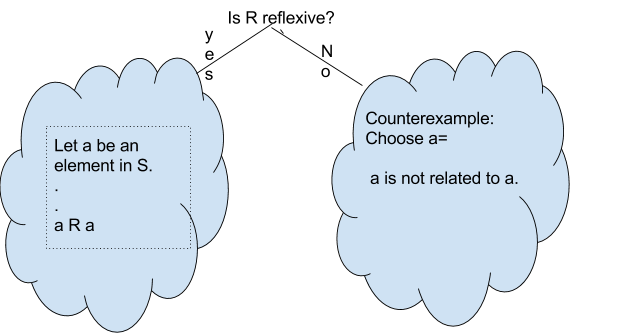
Example \PageIndex{7}:
Define R by a R b if and only if a < b, for a, b \in \mathbb{Z}. Is R reflexive?
Counter Example:
Choose a=2.
Since 2 \not< 2, R is not reflexive.
Example \PageIndex{8}:
Define R by a R b if and only if a \mid b, for a, b \in \mathbb{Z}. Is R reflexive?
Proof:
Let a \in \mathbb{Z}. Since a=(1) (a), a \mid a.
Thus R is reflexive. \Box
Definition: Symmetric
Let S be a set and R be a binary relation on S. Then R is said to be symmetric if the following statement is true:
\forall a,b \in S, if a R b then b R a, in other words, \forall a,b \in S, a R b \implies b R a.
Example \PageIndex{8}: Visually
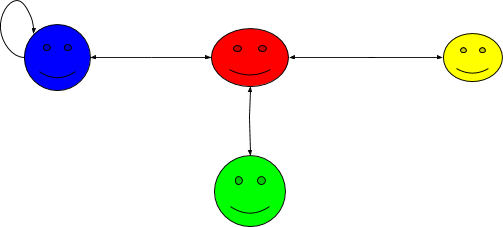
\forall a,b \in S, a R b \implies b R a. holds!
We will follow the template below to answer the question about symmetric.
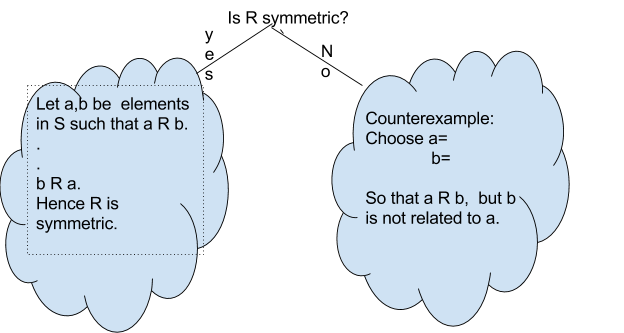
Example \PageIndex{9}:
Define R by a R b if and only if a < b, for a, b \in \mathbb{Z}. Is R symmetric?
Counter Example:
1<2 but 2 \not < 1.
Example \PageIndex{10}:
Define R by a R b if and only if a \mid b, for a, b \in \mathbb{Z}. Is R symmetric?
Counter Example:
2 \mid 4 but 4 \not \mid 2.
Definition: Transitive
Let S be a set and R be a binary relation on S. Then R is said to be transitive if the following statement is true
\forall a,b,c \in S, if a R b and b R c, then a R c.
In other words, \forall a,b,c \in S, a R b \wedge b R c \implies a R c.
Example \PageIndex{14}: VISUALLY
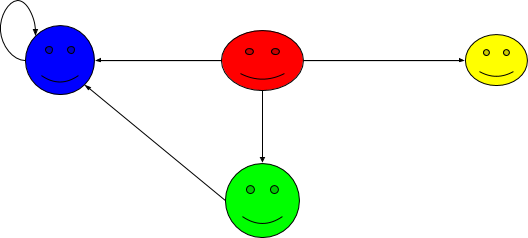
\forall a,b,c \in S, a R b \wedge b R c \implies a R c holds!
We will follow the template below to answer the question about transitive.
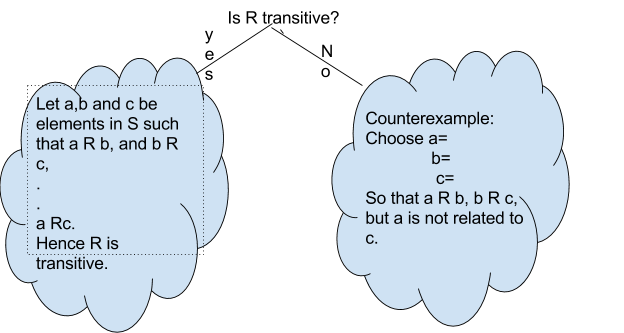
Example \PageIndex{15}:
Define R by a R b if and only if a < b, for a, b \in \mathbb{Z}. Is R transitive?
Example \PageIndex{16}:
Define R by a R b if and only if a \mid b, for a, b \in \mathbb{Z_+}. Is R transitive?
Definition: Equivalence Relation
A binary relation is an equivalence relation on a nonempty set S if and only if the relation is reflexive(R), symmetric(S) and transitive(T).
Definition: Equivalence Relation
Example \PageIndex{1}: =
Let S=\mathbb{R} and R be =. Is the relation a) reflexive, b) symmetric, c) antisymmetric, d) transitive, e) an equivalence relation, f) a partial order.
Solution:
-
Yes R is reflexive.
Proof:
Let a \in \mathbb{R} .
Then a=a .
Hence R is reflexive. \blacksquare
Yes R is symmetric.
Proof:
Let (a,b) \in \mathbb{R} such that a=b.
Clearly b=a .
Hence R is symmetric. \blacksquare
Yes R is antisymmetric.
Proof:
Let a,b \in \mathbb{R} s.t. a=b and b=a . Then clearly a=b \; \forall a,b \in \mathbb{R} . \blacksquare
Yes R is transitive.
Proof:
Let a,b,c \in \mathbb{R} s.t. a=b and b=c .
We shall show that aRc .
Since a=b and b=c it follows that a=c
Thus aRc . \blacksquare
Yes R is an equivalence relation.
Proof:
Since R is reflexive, symmetric and transitive, it is an equivalence relation.
Yes R is a partial order.
Proof:
Since R is a partial order since R is reflexive, antisymmetric and transitive.
Example \PageIndex{2}: Less than or equal to
Let S=\mathbb{R} and R be \leq. Is the relation a) reflexive, b) symmetric, c) antisymmetric, d) transitive, e) an equivalence relation, f) a partial order.
Solution
Proof:
Counterexample:
It is true that , but it is not true that
.
Proof:
We will show that given and
that
.
Proof:
We will show that given and
that
.
5. No, is not an equivalence relation on
since it is not symmetric.
6. Yes, is a partial order on
since it is reflexive, antisymmetric and transitive.
Definition: Equivalence Class
Given an equivalence relation R over a set S, for any a \in S the equivalence class of a is the set [a]_R =\{ b \in S \mid a R b \} , that is
[a]_R is the set of all elements of S that are related to a.
Example \PageIndex{3}: Equivalence relation
Define a relation that two shapes are related iff they are the same color. Is this relation an equivalence relation?
Equivalence classes are:

Example \PageIndex{4}:
Define a relation that two shapes are related iff they are similar. Is this relation an equivalence relation?
Equivalence classes are:

Let A be a nonempty set. A partition of A is a set of nonempty pairwise disjoint sets whose union is A.
Note
For every equivalence relation over a nonempty set S, S has a partition.
Theorem \PageIndex{1}
If \sim is an equivalence relation over a nonempty set S. Then the set of all equivalence classes is denoted by \{[a]_{\sim}| a \in S\} forms a partition of S.
This means
1. Either [a] \cap [b] = \emptyset or [a]=[b], for all a,b\in S.
2. S= \cup_{a \in S} [a].
- Proof
-
Assume
is an equivalence relation on a nonempty set
.
Let
. If
, then we are done. Otherwise,
Let
be the common element between them.
Then
and
, which means that
and
.
Since
is an equivalence relation and
.
Since
and
(due to transitive property),
.
For the following examples, determine whether or not each of the following binary relations on the given set
is reflexive, symmetric, antisymmetric, or transitive. If a relation has a certain property, prove this is so; otherwise, provide a counterexample to show that it does not. If
is an equivalence relation, describe the equivalence classes of
.
Example \PageIndex{5}:
Let S = \{0, 1, 2, 3, 4, 5, 6, 7, 8, 9\}. Define a relation R on A = S \times S by (a, b) R (c, d) if and only if 10a + b \leq 10c + d.
Solution
Proof:
Counter Example:
Since ,
is not symmetric on
.◻
Proof:
Thus is antisymmetric on
.◻
5. is transitive on .
Proof:
6. is not an equivalence relation since it is not reflexive, symmetric, and transitive.
Example \PageIndex{6}:
Let . Define a relation
on
, by
if and only if
Solution
Proof:
Clearly since
and a negative integer multiplied by a negative integer is a positive integer in
.
Since ,
is reflexive on
.◻
2. is symmetric on .
Proof:
Counter Example:
Since ,
is not antisymmetric on
.◻
Proof:
There are two cases to be examined:
Since in both possible cases
is transitive on
.◻
5. Since is reflexive, symmetric and transitive, it is an equivalence relation. Equivalence classes are
and
.
Note this is a partition since or
. So we have all the intersections are empty.
Recall:
Let m,n \in \mathbb{Z}.
We say that m divides n (written as m|n) if n=mk for some k\in \mathbb{Z}.
Let S= \mathbb{Z}, m\in \mathbb{Z}_+. Define aRb if and only if m|(a-b), \forall a,b \in \mathbb{Z}.
Note that m is a positive integer.
Let m=3. Choose a=1 and b=2.
Are 1 and 2 related? i.e. does 3|1-2? Does 1-2=3k, k\in \mathbb{Z}? Since there is no integer k s.t. -1 = 3k, ∴ 1 is not related to 2.
However, we can see that we have three groups, as shown in the image below:
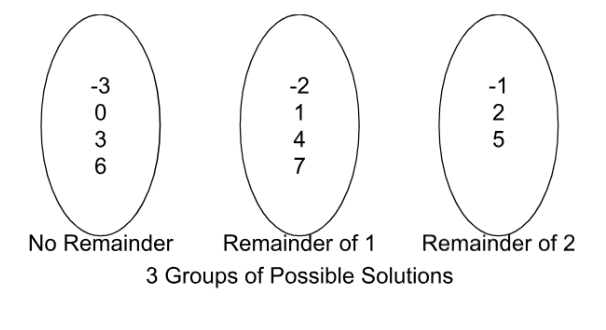
Definition: Modulo
Let m \in \mathbb{Z_+}.
a is congruent to b modulo m denoted as a \equiv b (mod \, n) , if a and b have the remainder when they are divided by n, for a, b \in \mathbb{Z}.
Properties
Let n \in \mathbb{Z_+}. Then
Theorem 1 :
Two integers a and b are said to be congruent modulo n, a \equiv b (mod \, n), if all of the following are true:
a) m\mid (a-b).
b) both a and b have the same remainder when divided by n.
c) a-b= kn, for some k \in \mathbb{Z}.
NOTE: Possible remainders of n are 0, ..., n-1.
Reflexive Property
Theorem 2:
The relation " \equiv " over \mathbb{Z} is reflexive.
Proof: Let a \in \mathbb{Z} .
Then a-a=0(n), and 0 \in \mathbb{Z}.
Hence a \equiv a (mod \, n).
Thus congruence modulo n is Reflexive.
Symmetric Property
Theorem 3:
The relation " \equiv " over \mathbb{Z} is symmetric.
Proof: Let a, b \in \mathbb{Z} such that a \equiv b (mod n).
Then a-b=kn, for some k \in \mathbb{Z}.
Now b-a= (-k)n and -k \in \mathbb{Z}.
Hence b \equiv a(mod \, n).
Thus the relation is symmetric.
Antisymmetric Property
Is the relation " \equiv " over \mathbb{Z} antisymmetric?
Counter Example: n is fixed
choose: a= n+1, b= 2n+1, then
a \equiv b(mod \, n) and b \equiv a (mod \, n)
but a \ne b.
Thus the relation " \equiv "on \mathbb{Z} is not antisymmetric.
Transitive Property
Theorem 4 :
The relation " \equiv " over \mathbb{Z} is transitive.
Proof: Let a, b, c \in \mathbb{Z}, such that a \equiv b (mod n) and b \equiv c (mod n).
Then a=b+kn, k \in \mathbb{Z} and b=c+hn, h \in \mathbb{Z}.
We shall show that a \equiv c (mod \, n).
Consider a=b+kn=(c+hn)+kn=c+(hn+kn)=c+(h+k)n, h+k \in \mathbb{Z}.
Hence a \equiv c (mod \, n).
Thus congruence modulo n is transitive.
Theorem 5:
The relation " \equiv " over \mathbb{Z} is an equivalence relation.
Modulo classes
Let . The relation \equiv on
by a \equiv b if and only if
, is an equivalence relation. The Classes of
have the following equivalence classes:
Example of writing equivalence classes:
Modulo Arithmetic
In this section, we will explore arithmetic operations in a modulo world.
Let n \in \mathbb{Z_+}.
Theorem 5 :
Let a, b, c,d, \in \mathbb{Z} such that a \equiv b (mod\,n) and c \equiv d (mod\, n). Then (a+c) \equiv (b+d)(mod\, n).
- Proof:
-
Let a, b, c, d \in\mathbb{Z}, such that a \equiv b (mod\, n) and c \equiv d (mod \,n).
We shall show that (a+c) \equiv (b+d) (mod\, n).
Since a \equiv b (mod\, n) and c \equiv d (mod\, n), n \mid (a-b) and n \mid (c-d)
Thus a= b+nk, and c= d+nl, for k and l \in \mathbb{Z}.
Consider (a+c) -( b+d)= a-b+c-d=n(k+l), k+l \in \mathbb{Z}.
Hence (a+c)\equiv (b+d) (mod \,n).\Box
Theorem 6:
![]()
Let a, b, c,d, \in \mathbb{Z} such that a \equiv b (mod \, n) and c \equiv d (mod \,n). Then (ac) \equiv (bd) (mod \,n).
- Proof:
-
Let a, b, c, d \in \mathbb{Z}, such that a \equiv b (mod\, n) and c \equiv d (mod \, n).
We shall show that (ac) \equiv (bd) (mod\, n).
Since a \equiv b (mod \,n) and c \equiv d (mod\, n), n \mid (a-b) and n \mid (c-d)
Thus a= b+nk, and c= d+nl, for k and l \in \mathbb{Z}.
Consider (ac) -( bd)= ( b+nk) ( d+nl)-bd= bnl+dnk+n^2lk=n (bl+dk+nlk), where (bl+dk+nlk) \in \mathbb{Z}.
Hence (ac) \equiv (bd) (mod \,n).\Box
Theorem 7:
Let a, b \in \mathbb{Z} such that a \equiv b (mod \, n) . Then a^2 \equiv b^2 (mod \, n).
- Proof:
-
Let a, b \in \mathbb{Z}, and n \in \mathbb{Z_+}, such that a \equiv b (mod \, n).
We shall show that a^2 \equiv b^2 (mod \, n).
Since a \equiv b (mod \, n), n\mid (a-b).
Thus (a-b)= nx, where x \in \mathbb{Z}.
Consider (a^2 - b^2) = (a+b)(a-b)=(a+b)(nx), = n(ax+bx), ax+bx \in \mathbb{Z}.
Hence n \mid a^2 - b^2, therefore a^2 \equiv b^2 (mod \, n). \Box
Theorem 8:
Let a, b \in \mathbb{Z} such that a \equiv b (mod \, n). Then a^m \equiv b^m (mod \, n), \forall \in \mathbb{Z}.
- Proof:
-
Exercise.
By using the above result, we can solve many problems. Some of them are discussed below:
Example \PageIndex{1}: mod\, 3 Arithmetic
Let n = 3.
Addition
| + | [0] | [1] | [2] |
| [0] | [0] | [1] | [2] |
| [1] | [1] | [2] | [0] |
| [2] | [2] | [0] | [1] |
Multiplication
| x | [0] | [1] | [2] |
| [0] | [0] | [0] | [0] |
| [1] | [0] | [1] | [2] |
| [2] | [0] | [2] | [1] |
Example \PageIndex{2}: mod\, 4 Arithmetic
Let n=4.
| x | [0] | [1] | [2] | [3] |
| [0] | [0] | [0] | [0] | [0] |
| [1] | [0] | [1] | [2] | [3] |
| [2] | [0] | [2] | [0] | [2] |
| [3] | [0] | [3] | [2] | [1] |
Example \PageIndex{3}:
Find the remainder when (101)(103)(107)(109) is divided by 11.
- Answer
-
101 \equiv 2 (mod \, 11)
103 \equiv 4 (mod \, 11)
107 \equiv 8 (mod \, 11)
109 \equiv 10 (mod \,11).
Therefore,
(101)(103)(107)(109) \equiv (2)(4)(8)(10) (mod \,11) \equiv 2 (mod \,11).
Example \PageIndex{4}:
Find the remainder when 7^{1453} is divided by 8.
- Answer
-
7^0 \equiv 1 (mod \, 8)
7^1 \equiv 7 (mod \, 8)
7^2 \equiv 1 (mod \, 8)
7^3 \equiv 7 (mod \, 8),
As there is a consistent pattern emerging and we know that 1453 is odd, then 7^{1453} \equiv 7 (mod \, 8). Thus the remainder is 7.
Example \PageIndex{5}:
Find the remainder when 7^{2020} is divided by 18.
- Answer
-
7^0 \equiv 1 (mod \, 18)
7^1 \equiv 7 (mod \, 18)
7^2 \equiv 13 (mod \, 18)
7^3 \equiv 1 (mod \, 18),
As there is a consistent pattern emerging and we know that 2020=(673)3+1, 7^{2020}= 7^{(673)3+1}=\left( 7^3\right)^{673}7^1 \equiv 7 (mod \, 18). Thus the remainder is 7.
Example \PageIndex{6}:
Find the remainder when 26^{1453} is divided by 3.


